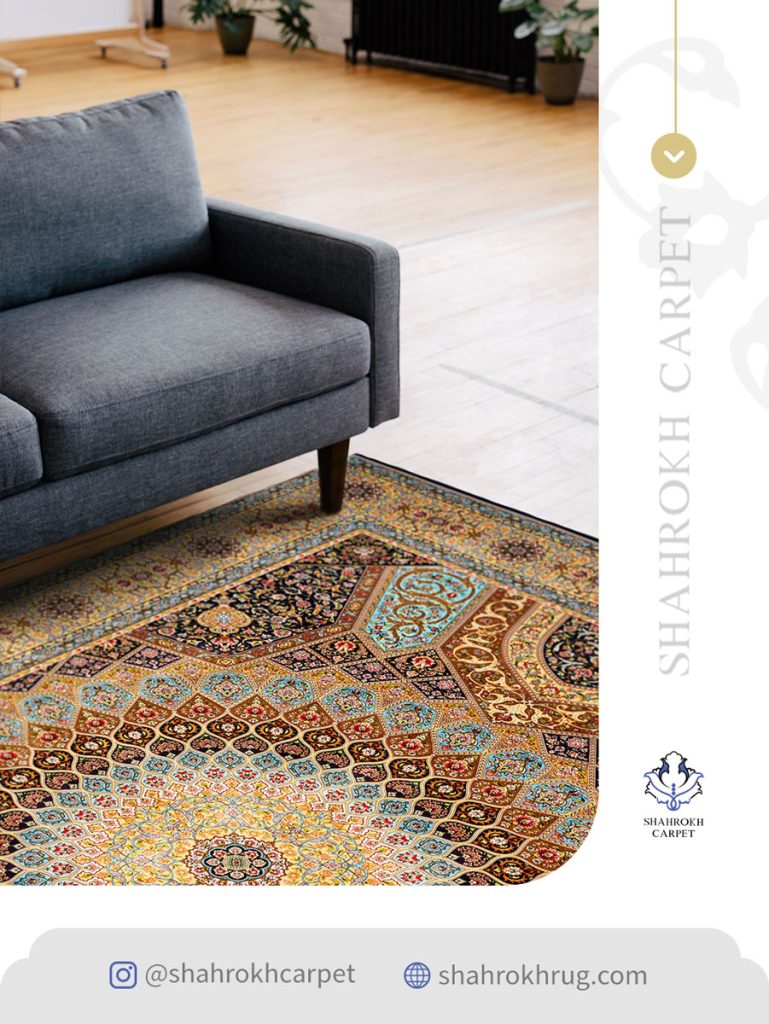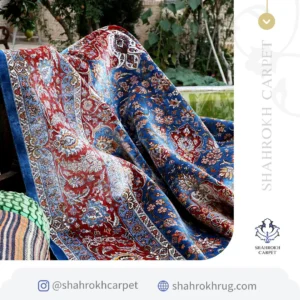Persian rugs are not just carpets; they are timeless works of art that showcase centuries of craftsmanship, tradition, and beauty. Known for their intricate designs, diverse patterns, and vibrant colors, Persian rugs have captivated enthusiasts and collectors worldwide. In this guide, we will explore the types of Persian rugs, their designs, and how to identify them to help you choose the perfect piece for your space.

What are Persian Rugs
Persian rugs, also known as Persian carpets, originate from Iran (formerly Persia) and are handwoven by skilled artisans. Each rug is a unique reflection of the culture and region it comes from, featuring distinctive motifs, patterns, and materials.
When exploring types of Persian rugs with pictures, you’ll notice the striking variety that sets them apart. Whether you are seeking a decorative centerpiece for your living room or a collectible masterpiece, Persian rugs offer endless choices.

Different Types of Persian Rugs
Persian rugs are categorized based on the regions or cities they are crafted in. Each area has its own unique style, knotting technique, and design features. Below are the different types of Persian rugs:
A. Tabriz Rugs
Tabriz rugs are one of the most well-known types of Persian carpets. Originating from the city of Tabriz in northwestern Iran, these rugs are famous for their fine knots, elegant floral patterns, and detailed medallion designs. Tabriz rugs often feature neutral backgrounds with soft blues, reds, and ivory tones.
B. Kashan Rugs
Kashan rugs, woven in central Iran, are admired for their luxurious feel and intricate patterns. These rugs often showcase central medallions surrounded by detailed floral motifs and vine work. Types of Persian rug patterns in Kashan carpets are known for their symmetry and harmony.
C. Isfahan Rugs
Isfahan rugs are known for their precision and high knot density. These rugs often incorporate silk threads, adding a luxurious texture and shine. Designs typically include central medallions with symmetrical floral and vine patterns.
D. Qom Rugs
Qom rugs, sometimes referred to as silk Persian rugs, are highly sought-after for their luxurious appearance. These rugs are often crafted with pure silk or silk-wool blends, making them exceptionally soft and shiny. They are smaller in size but extremely detailed.
E. Nain Rugs
Nain rugs feature intricate designs and a lighter color palette, including cream, ivory, and blues. These rugs often incorporate floral patterns and central medallions, making them versatile for modern and traditional interiors.
F. Heriz Rugs
Heriz rugs are known for their bold, geometric designs and durable construction. These rugs are perfect for high-traffic areas due to their sturdiness. The types of Persian rug designs in Heriz rugs include angular patterns and large medallions.
G. Bakhtiari Rugs
Bakhtiari rugs are tribal rugs with vibrant colors and garden-inspired designs. The “garden panel” layout, featuring squares or rectangles filled with floral or animal motifs, is a hallmark of Bakhtiari patterns.
H. Qashqai Rugs
Qashqai rugs, woven by nomadic tribes, boast bold geometric patterns, vivid colors, and tribal motifs. These rugs reflect the artistic expressions of their creators and are perfect for adding a rustic charm to any space.
How to Identify Types of Persian Rugs
Identifying types of Persian rugs requires an understanding of their design, knotting style, and origin. Here are some tips to help you recognize the differences:
- Patterns and Motifs: Look closely at the patterns. Floral designs, medallions, and geometric motifs can indicate the rug’s origin (e.g., Kashan, Heriz, or Tabriz).
- Colors: Color palettes often reflect regional styles. For example, Isfahan rugs feature soft creams and blues, while Qashqai rugs use bold reds and deep blues.
- Material: Persian rugs are typically made from wool, silk, or a combination of both. Silk rugs, like those from Qom, are known for their softness and shine.
- Knot Density: The knot count per square inch indicates the quality of the rug. Rugs from Isfahan and Qom typically have a higher knot density, resulting in intricate details.
- Border and Fringe: Pay attention to the borders and fringes, as these often carry unique patterns that distinguish one type from another.
Types of Persian Rug Designs and Patterns
Persian rugs feature a wide range of designs and patterns, each with symbolic meaning and artistic value. The most common types of Persian rug patterns include:
- Medallion and Corner Design: A central medallion surrounded by corner motifs, common in Kashan and Isfahan rugs.
- All-Over Design: Repeating floral or geometric patterns without a central focal point, often found in Heriz and Bakhtiari rugs.
- Garden Design: Panel-style layouts filled with floral or animal motifs, prominent in Bakhtiari rugs.
- Tribal and Geometric Design: Bold, angular patterns with vibrant colors, seen in Qashqai and Heriz rugs.

Why Choose Persian Rugs?
Investing in a Persian rug means acquiring a piece of history, art, and exceptional craftsmanship. Key reasons to choose Persian rugs include:
- Timeless Beauty: Persian rugs enhance the aesthetic appeal of any space with their intricate designs and vibrant colors.
- Durability: Handwoven Persian rugs are built to last, often becoming family heirlooms passed down through generations.
- Cultural Significance: Each Persian rug tells a story of the region and artisans who created it.
- Variety: From types of Persian carpets to tribal designs, there’s a rug for every style and preference.
Shahrokh Rugs: A Trusted Source for Persian Carpets
If you’re looking for high-quality Persian rugs, Shahrokh Rugs offers a curated selection of the finest types of Persian rugs. As a trusted name in the industry, Shahrokh combines tradition with quality, ensuring that each rug reflects the beauty and artistry of Persian craftsmanship.
At Shahrokh Rugs, you’ll find a variety of styles, including different types of Persian rugs such as Tabriz, Kashan, and Qom. Each piece is hand-selected to provide durability, elegance, and cultural authenticity.
Conclusion: Explore the Types of Persian Rugs
Persian rugs are a symbol of beauty, tradition, and artistry, offering endless options for collectors and homeowners. From the luxurious silk designs of Qom to the bold patterns of Heriz, the types of Persian rugs available today cater to every taste and style.
Whether you’re exploring types of Persian rugs with pictures or seeking to identify different types of Persian rugs, understanding their origins, patterns, and materials will help you make an informed decision. Discover the world of Persian rugs with Shahrokh Rugs and bring timeless elegance to your space.








